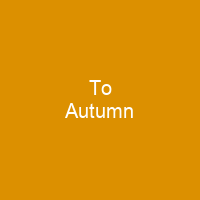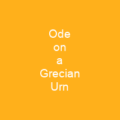The poem was composed on 19 September 1819 and published in 1820 in a volume of Keats’s poetry that included Lamia and The Eve of St. Agnes. It has been interpreted as a meditation on death; as an allegory of artistic creation; as a response to the Peterloo Massacre, which took place in the same year; and as an expression of nationalist sentiment.
About To Autumn in brief

In his free time he also read works as varied as Robert Burton’s The Anatomy of Melancholy, Thomas Chatterton’s poetry, and Leigh Hunt’s essays. In the spring of 1819, he wrote many of his major odes: \”Ode on a Grecian Urn\”, ‘Ode to a Nightingale’, and “Ode of Psyche’. His efforts from spring until autumn were dedicated completely to a career in poetry, alternating between writing long and short poems, and setting himself a goal to compose more than fifty lines of verse each day. Although Keats managed to write many poems in 1819 he was suffering from a multitude of financial troubles throughout the year, including concerns over his brother, George, who, after emigrating to America, was badly in need of money. Despite these distractions, he found time to write “To Autumn’”. The poem marks the final moment of his career as a poet, as he needed to earn money and could no longer devote himself to the lifestyle of a poet. It has parallels in the work of English landscape artists, with Keats himself describing the fields of stubble that he saw on his walk as conveying the warmth of ‘some pictures’ in the poem. It is regarded by critics as one of the most perfect short poems in the English language.
You want to know more about To Autumn?
This page is based on the article To Autumn published in Wikipedia (as of Nov. 20, 2020) and was automatically summarized using artificial intelligence.







